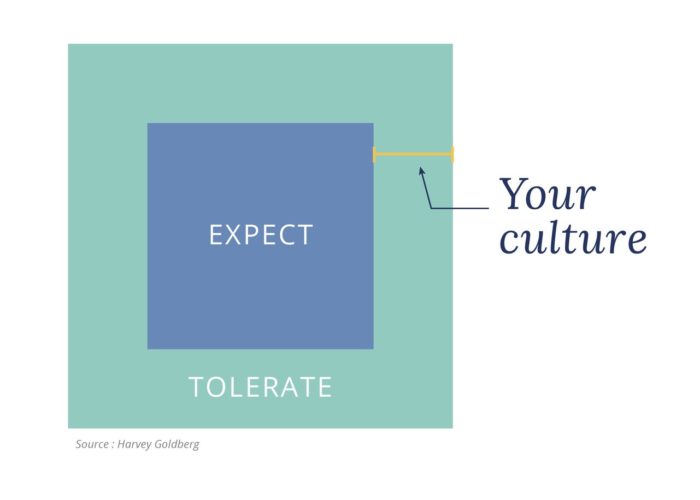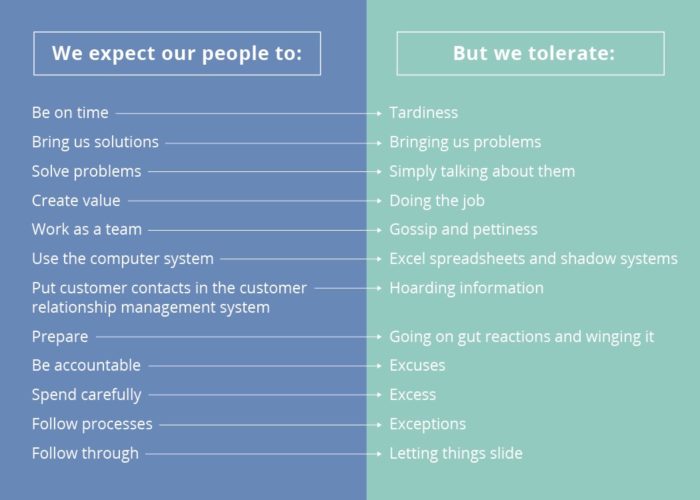
I’m obsessing lately about a presentation Harvey Goldberg gave on leadership. He asked a simple question: “What do you expect from your people?” Then he asked, “Now, what do you tolerate from them?” He then drew the two squares above and said, “What you tolerate is what you will get, and that becomes your company culture.”
Our job is to align what we tolerate and what we expect…to get to zero gap.

Think about it.
Read down the columns. What kind of performance do you expect from an organization that exhibits the behavior on the left? How about the right?
And would people in your company be able to come up with the list on the left, on their own?

Why do we tolerate poor performance?
We are leaders responsible for running successful organizations. We are accustomed to giving direction and we are accountable for results. Yet that gap between what we tolerate and what we expect exists for all of us. There are some simple explanations.
We look away. Ever have that “how did we get here” moment? When I started my company, I didn’t look closely at employee expense reports. People would take their colleagues out to lunch. Those lunches became weekly events at wonderful restaurants. They soon involved wine and no clients. Then one month-end, I found myself staring at $30,000 of internal employee restaurant expenses. A grain of sand is nearly invisible, but in bulk it becomes a beach.
We rationalize. Do you tell yourself things like, “I don’t like admin; I’m not that person’s parent; I should empower people; I believe people will naturally do the right thing?” Our internal dialogue is based on how we want to see ourselves and the world. That dialogue is storytelling; we often tell ourselves stories that let people off the hook. Look at your story. Is it enabling people to behave badly? How does the story you tell yourself serve you?
It’s the path of least resistance. Accountability takes work and it takes vigilance. Letting things slide is easier – in the short term — than holding people accountable. Creating clear guidelines, setting expectations, establishing measures, then following up is intellectual and emotional work. And it takes time. Letting your standards slide is easier.
We don’t like confrontation. Everyone likes to be liked. And telling someone that they are not living up to our expectations means we risk a negative response – defensiveness, excuses, embarrassment, or rejection. We encounter what Dale Carnegie observed: “When dealing with people, remember you are not dealing with creatures of logic, but creatures of emotion.” And many of us find that uncomfortable.
How do we get the culture we expect?
- Identify essential behaviors. What do you expect of your people? Make a list like the one in the table above. Detailing what you expect will help you be clear when you give direction.
- Prioritize and focus. You have a limited amount of time and capacity, so focus your energy on one behavior at a time. Map the behaviors on a grid – low to high impact, vs. low to high difficulty. What is high-impact and easy to do? Start with those behaviors to establish a foundation, and then build on it.
- Hold people accountable for one behavior per quarter. Research by Phillippa Lally and her team shows that it takes 66 days on average to ingrain a habit, but since business tends to run in quarterly cycles, a three-month cadence is just fine.
- When you are tempted to let a bad behavior slide, ask yourself, ”What if everyone in the company exhibited this behavior?” If you visualize the behavior as it scales across the organization, you will see the urgency. This can be a helpful shot of motivation.
- When you see the behavior that is not what you expect, ask the responsible person directly: “Why is this ok?” Help them see the gap that you see. If they don’t see it, they can’t close it.
Behavior drives culture. Culture drives results. You might expect performance, but in the end, you will get what you’re willing to tolerate.




